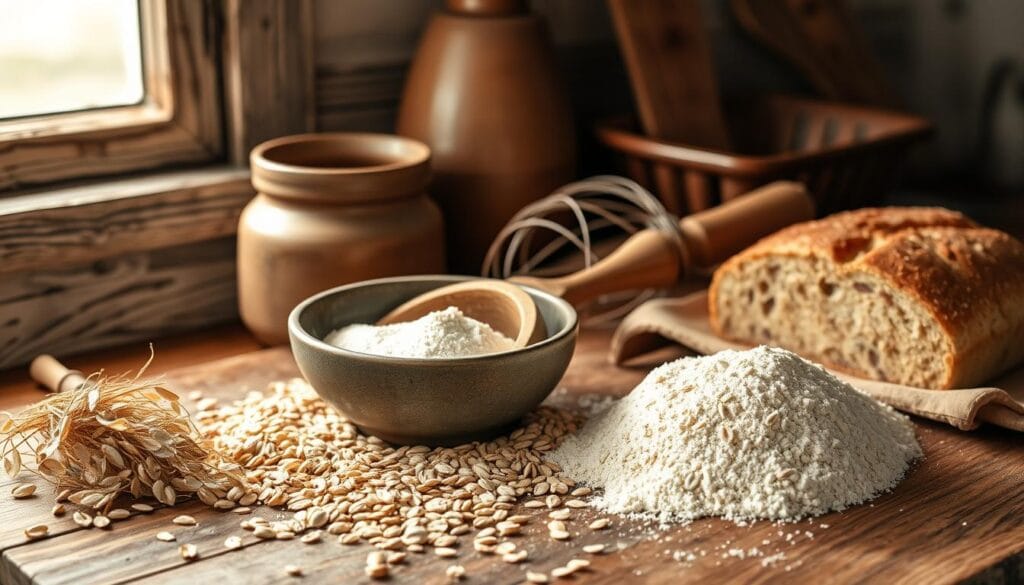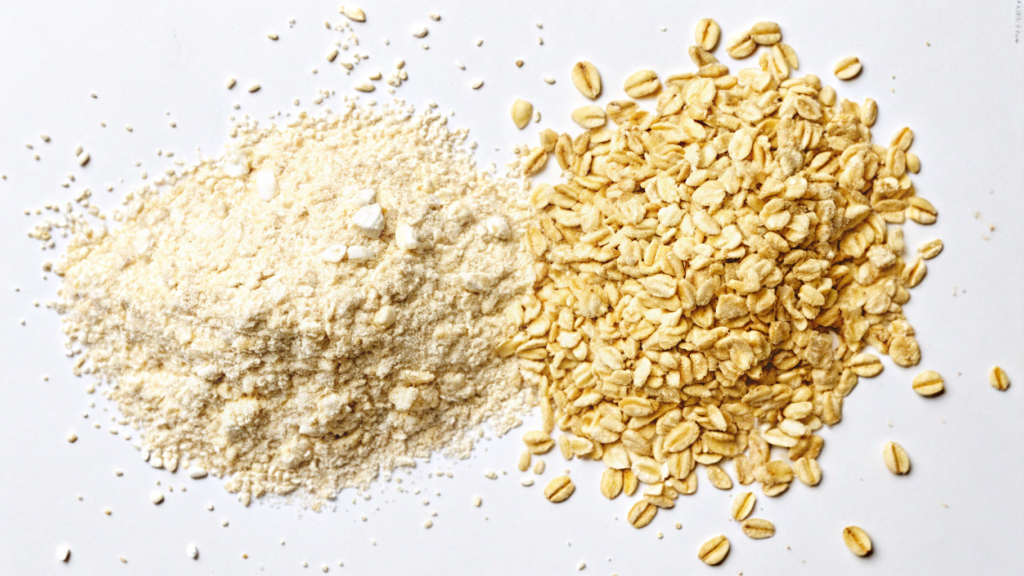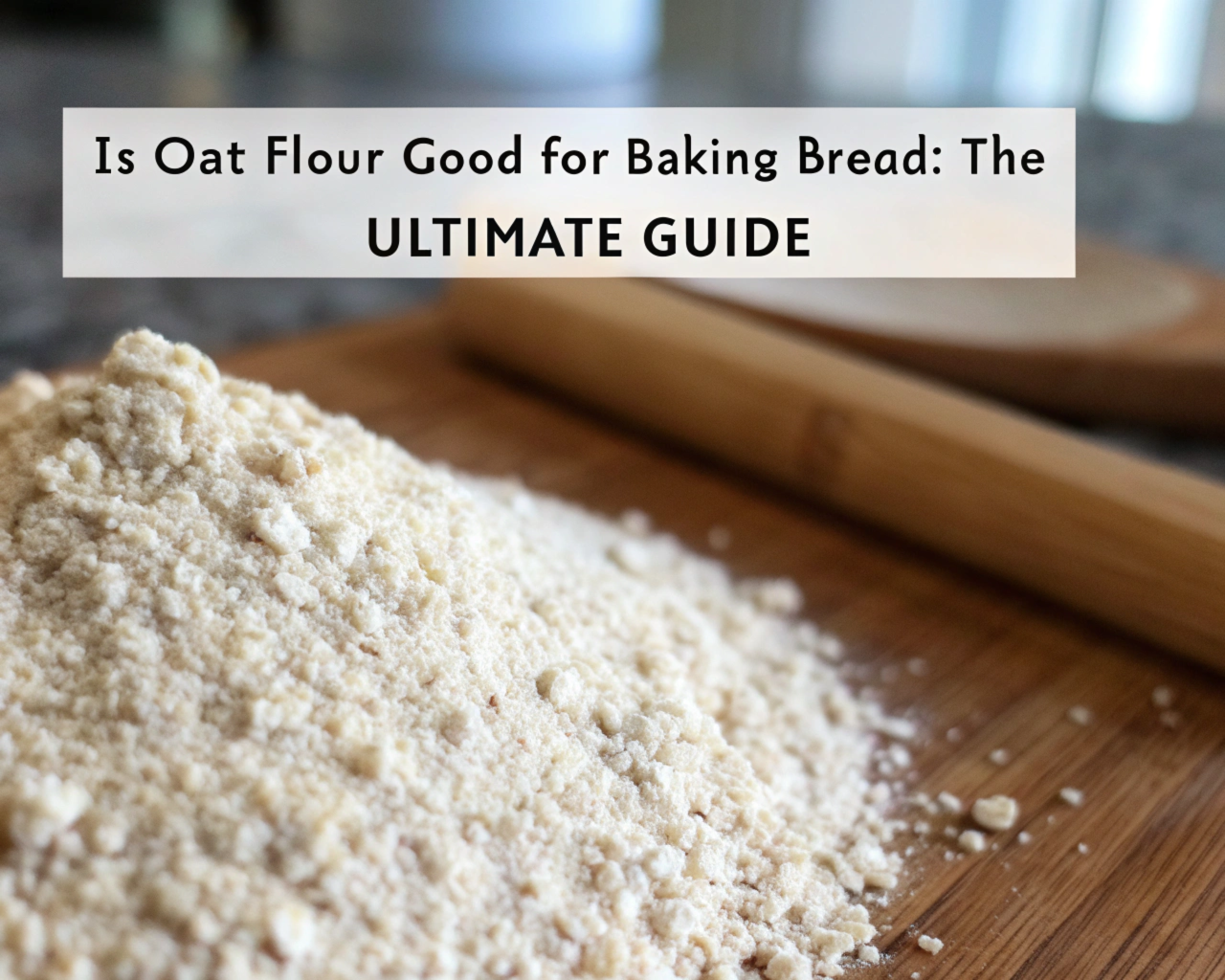Oat Flour For Bread Baking: In the world of baking, people are looking for healthier options. Oat flour has become a favorite among health-conscious bakers. But is it good for baking bread? This guide will look into oat flour’s benefits and challenges for bread baking.

Table of Contents
Understanding Oat Flour: Nutritional and Baking Benefits
Oat flour, whether whole grain or finely ground, offers a robust nutritional profile with dietary fiber, B vitamins, and minerals like iron and magnesium. Its nutty and slightly sweet flavor elevates baked goods, providing a rustic yet tender texture. For those pursuing gluten-free diets, oat flour is a popular alternative, though it requires additional planning to achieve the desired results.
For inspiration, explore this easy banana bread recipe using oat flour to see how the ingredient shines in action.
Different Types of Oat Flour Available
- Whole Grain Oat Flour: Made by grinding the entire oat grain, including the bran and germ, providing maximum nutritional benefits.
- Oat Flour: Produced by grinding the oat groats (the inner part of the oat grain) into a fine powder.
- Instant Oat Flour: A finely ground version of oat flour that is designed for easier incorporation into recipes.
How Oat Flour Differs from Traditional Flour
Oat flour tastes nutty and slightly sweet. It has a coarser texture and more moisture content than traditional flour. These differences make oat flour great for baking healthier and tastier treats.
Oat Flour For Bread Baking
Oat flour is great for baking bread. It’s versatile and adds benefits to both gluten-free baking and traditional bread recipes. It improves texture and flavor.
Oat flour is gluten-free, making it perfect for those on a gluten-free diet. It’s a safe choice for making soft, tender, and flavorful bread. This is unlike all-purpose flour, which needs gluten for structure.
Oat flour also adds a nutty, slightly sweet flavor to bread. This unique taste enhances the flavor profile of your baked goods. It works well with many ingredients.
The texture of oat flour is also noteworthy. Its coarser grind gives bread a rustic feel. Yet, it still has a soft and tender crumb. It’s great for artisanal-style loaves and sandwich breads.
But, using Oat Flour For Bread Baking might need recipe tweaks. Its lower gluten and higher water absorption require adjustments in mixing, rising, and baking. With some trial and error, you can make delicious, nutritious, and visually appealing bread.
In summary, oat flour is a great pick for bread baking. It offers benefits like gluten-free baking, texture, and flavor. By understanding its unique traits and using the right methods, you can make exceptional homemade bread.
The Science Oat Flour For Bread Baking
Oat Flour For Bread Baking is a fascinating journey into the science of its unique properties. It’s important to know about its gluten content, moisture absorption, and baking temperature. These factors help you use oat flour to its fullest potential.
Gluten Content and Structure Formation
Oat flour has less gluten than regular flour. This can make baking a bit tricky. But it also means you can make tender and moist treats. By mixing oat flour with other ingredients right, you can get the perfect texture and rise in your bread.
Moisture Absorption Properties
Oat flour is great at absorbing moisture. This makes your bread soft and supple. Knowing how to use this property helps prevent dry or crumbly baked goods.
Temperature Considerations
The baking temperature is key when using oat flour. Because it has less gluten, you might need to bake at a lower temperature for longer. This ensures your bread is evenly cooked and has a nice golden crust.
Learning about oat flour’s science helps you make amazing bread. With this knowledge, you can confidently bake delicious treats with oat flour.
| Property | Characteristic | Impact on Baking |
|---|---|---|
| Gluten Content | Lower than all-purpose flour | Affects structure formation and texture |
| Moisture Absorption | Higher than all-purpose flour | Helps retain moisture in baked goods |
| Baking Temperature | Requires lower temperatures and longer baking times | Prevents overbrowning and ensures even cooking |
“Understanding the science behind baking with oat flour is the key to unlocking its full potential and creating exceptional bread.”
Substituting Oat Flour for All-Purpose Flour in Bread Recipes
Oat Flour For Bread Baking is a fun and healthy way to change up your recipes. It’s key to know how to swap it for all-purpose flour to get great results.
For a 1:1 swap, use one cup of oat flour for every cup of all-purpose flour. But, oat flour soaks up more liquid than all-purpose flour. So, you might need to add less liquid to your recipe.
| Ingredient | All-Purpose Flour | Oat Flour |
|---|---|---|
| Flour | 1 cup | 1 cup |
| Liquid (e.g., water, milk, or broth) | 1 cup | Start with 3/4 cup and adjust as needed |
Start with 3/4 cup of liquid for every 1 cup of oat flour. Then, adjust the liquid as needed to get the right dough consistency.
Oat flour makes baked goods denser than all-purpose flour. Adding vital wheat gluten or mixing oat flour with all-purpose flour can help.
Remember, the exact swap ratios and adjustments depend on the recipe and bread type. Always experiment and tweak to find the perfect mix of texture, taste, and nutrition in your oat flour bread.
Tips for Successful Oat Flour For Bread Baking
Mastering oat flour baking needs focus on measuring, binding agents, and rising methods. Follow these tips for delicious and textured oat flour bread.
Proper Measurement Techniques
Getting the right amount of oat flour is key. It acts differently than regular flour. Here’s how to measure it accurately:
- Use a spoon to scoop oat flour into a measuring cup. Level it off with a knife. Don’t pack or scoop from the container.
- For the best results, weigh oat flour with a digital scale. This is great when replacing all-purpose flour.
- Fluff the oat flour before measuring. This prevents it from being too dense in your baked goods.
Essential Binding Agents
Oat flour lacks gluten, so you need binding agents. These help your bread stay together. Try these:
- Eggs: Eggs’ proteins bind ingredients, giving structure and stability.
- Xanthan gum: A small amount improves texture and prevents crumbling.
- Ground flaxseeds: Mixed with water, they create a gel that binds ingredients.
Optimal Rising Methods
Proper rising is key for a light texture. Here’s how to do it right:
- Proof the dough in a warm, draft-free spot, like an oven with the light on.
- Keep the dough covered with a damp towel or plastic wrap to prevent drying.
- Let the dough rise for the full time. Oat flour may need longer than wheat flour.
Follow these tips to make tasty oat flour bread. Your family and friends will love it.

Challenges and Solutions in Oat Flour For Bread Baking
While oat flour boasts several advantages, its lower gluten content and higher moisture absorption can pose challenges. Address these with the following strategies:
- Gluten Substitution: Use binding agents like eggs, xanthan gum, or ground flaxseeds to improve dough structure and prevent crumbling.
- Adjust Liquid Ratios: Start with ¾ cup of liquid per 1 cup of oat flour, gradually adjusting for the perfect dough consistency.
- Extend Rising Times: Allow more time for proofing to achieve an airy texture.
Check out these tips on why to use oat flour over all-purpose flour to better understand its role in healthier recipes.
Substituting Oat Flour For Bread Baking
Replacing all-purpose flour with oat flour requires thoughtful adjustments. Typically, oat flour can replace up to 50% of the all-purpose flour in a recipe without drastic changes. For a full substitution, pair oat flour with gluten-supporting ingredients or experiment with baking powder for better rise and texture.
Learn more from this resource on mastering almond and oat flour baking techniques, which provides insights for achieving balance and consistency.
Conclusion:Oat Flour For Bread Baking
Oat flour brings many benefits to bread baking. It’s packed with nutrients and has special baking qualities. Using oat flour can make your homemade bread healthier and tastier.
It’s easy to start using oat flour, whether you’re an expert or a beginner. Just mix it with your regular flour to see the difference. Your bread will look great and taste even better.
Success with oat flour bread comes from knowing how to use it. Adjust your recipes and be patient as you get better. This article will help you make delicious, oat-based breads that are good for you.
FAQ:Oat Flour For Bread Baking
Can I substitute oat flour for all-purpose flour in bread?
Yes, you can use oat flour instead of all-purpose flour in bread. You might need to adjust the ratio and baking steps. Oat flour is a healthy choice that can replace up to 50% of all-purpose flour in most recipes.
Is oat flour good for baking bread?
Absolutely, oat flour is great for baking bread. It’s packed with fiber, protein, and healthy fats. This makes it a better choice than traditional wheat flour. Used right, oat flour can make a tasty and nutritious bread.
Does baking powder make oat flour rise?
Baking powder helps oat flour rise, but it’s not the only thing. Oat flour has less gluten than all-purpose flour. This can make it harder to get a light texture. But, the right mix of baking powder and proper rising techniques can help.
Why use oat flour instead of all-purpose flour?
There are good reasons to choose oat flour over all-purpose flour. It’s more nutritious, with more fiber, protein, and healthy fats. It also brings a unique flavor to baked goods. Plus, it’s great for those who need gluten-free options or want a healthier flour choice.

